nazis
 The many atrocities of the Nazi soldiers are well known, but somehow, every time I read about another one, I am very shocked again. I suppose that the prisoners of war were treated better than the Jews or the political prisoners, but I don’t think it was enough better to really take notice of. The Third Reich was an equal opportunity murder machine. Somehow they felt certain that they could get away with anything they wanted to do.
The many atrocities of the Nazi soldiers are well known, but somehow, every time I read about another one, I am very shocked again. I suppose that the prisoners of war were treated better than the Jews or the political prisoners, but I don’t think it was enough better to really take notice of. The Third Reich was an equal opportunity murder machine. Somehow they felt certain that they could get away with anything they wanted to do.
During the Battle of the Bulge, which was a major German offensive campaign on the Western Front during World War II. It took place from December 16, 1944 to January 25, 1945. The battle was launched through the densely forested Ardennes region of Wallonia in eastern Belgium, northeast France, and Luxembourg, towards the end of the war in Europe. The war was winding down, and the Germans knew they were losing. It was during this time that they began trying to get rid of the evidence.
The Malmedy massacre was the result of their attempt to hide what they were doing. I was a war crime committed by members of Kampfgruppe Peiper, which is a part of the SS Division Leibstandarte, a German Waffen-SS unit led by Joachim Peiper, at Baugnez crossroads near Malmedy, Belgium, on December 17, 1944. 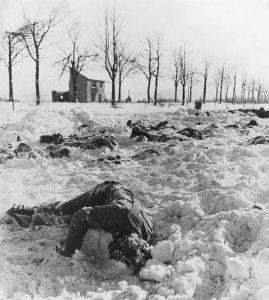 In all, 84 American prisoners of war were massacred by their German captors. The Germans assembled the prisoners in a field and mowed them down with machine guns. Afterward, they walked through the field and any of the prisoners who were still alive were killed by close-range shots to the head.
In all, 84 American prisoners of war were massacred by their German captors. The Germans assembled the prisoners in a field and mowed them down with machine guns. Afterward, they walked through the field and any of the prisoners who were still alive were killed by close-range shots to the head.
The term Malmedy massacre has also been generally associated with the series of massacres committed by the same unit on the same day and following days. These men were intent on getting rid of the evidence of their crimes. With these men living, they could tell the world how they had been treated. They felt that the if the men were dead, then Germany could get out of the war crimes. Nevertheless, they killed these men in vain, because the killings were the subject of the Malmedy massacre trial, which was part of the Dachau Trials of 1946.
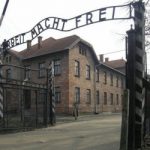
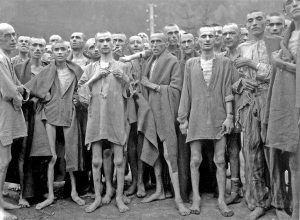 I read an article recently, that I can’t get out of my head. “A Study Finds 66% Of US Millennials Can’t Identify What Auschwitz Is” talks about the movement to remove certain elements from world history. The picture of Auschwitz is as foreign to kids these days as the idea of “The Final Solution” was prior to Hitler’s reign of terror in Germany and parts of Europe which led to the Holocaust. The thing that shocks me most is that when they were asked, after a tour of Auschwitz, which is located in Poland, why they didn’t tear these horrible buildings down, they responded, “Oh no!! We leave them up so that we will never forget what happened here, and never allow it to happen again.” Wise words, and words that more people would do well to remember today.
I read an article recently, that I can’t get out of my head. “A Study Finds 66% Of US Millennials Can’t Identify What Auschwitz Is” talks about the movement to remove certain elements from world history. The picture of Auschwitz is as foreign to kids these days as the idea of “The Final Solution” was prior to Hitler’s reign of terror in Germany and parts of Europe which led to the Holocaust. The thing that shocks me most is that when they were asked, after a tour of Auschwitz, which is located in Poland, why they didn’t tear these horrible buildings down, they responded, “Oh no!! We leave them up so that we will never forget what happened here, and never allow it to happen again.” Wise words, and words that more people would do well to remember today.
During the past year, we have seen unrest, protests, riots, and the “cancel culture” that has become almost the norm of our time. The schools don’t teach parts of history anymore, in an act of Historical Negationism or denialism. This is not about revising history based on new information that would correct history. Usually, the purpose of historical negation is to achieve a national, political aim, by transferring war-guilt, demonizing an enemy, providing an illusion of victory, or preserving a friendship. Sometimes the purpose of a revised history is to sell more books or to attract attention with a newspaper headline. The historian James M. McPherson said that negationists would want revisionist history understood as, “a consciously-falsified or distorted interpretation of the past to serve partisan or ideological purposes in the present” All of that sounds an awful lot like what we have going on today.
Couple Historical Negationism with “taking offence” or “political correctness” and you have a recipe for disaster. In many of the riots of recent days, the rioters have torn down our historical statues. To me, it doesn’t matter if they think the statue portrays someone they find offensive, or not. That person is a pert of history, good, bad, or ugly. A hero of the South, might not be a hero of the North, but to those in the South he or she might have been. Was a war hero from Germany any less a war hero to his countrymen, simply because he was forced to fight on the side of the Nazis? I don’t think so. In fact many of the German soldiers had no idea of what was happening in their own country. I’m not standing up for the rightness, nor against the wrongness of the people 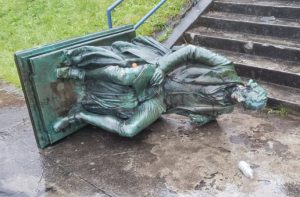
 portrayed in the statues, but rather against the destruction of property. The buildings destroyed in the riots, the statues destroyed by the mobs, the looting that took place, all deemed “okay” because these places had insurance…does not make these vicious acts acceptable, or their perpetrators blameless. It’s time that we teach our children about patriotism, respect, fairness, and decency. If we don’t, we are going to find ourselves in the middle of a country that is destroyed by violence and hate. Wake up America!!
portrayed in the statues, but rather against the destruction of property. The buildings destroyed in the riots, the statues destroyed by the mobs, the looting that took place, all deemed “okay” because these places had insurance…does not make these vicious acts acceptable, or their perpetrators blameless. It’s time that we teach our children about patriotism, respect, fairness, and decency. If we don’t, we are going to find ourselves in the middle of a country that is destroyed by violence and hate. Wake up America!!

 When Hitler decided that the time in his “final solution” had come to transport the Jews, Gypsies, and other “undesirables” to the death camps, he chose to transport them in cattle cars on a train. Hitler had so little compassion for human life, that when the people were loaded into the cattle cars, they were packed in tightly with as many 80 people to a car. They couldn’t sit down. The air was stifling. The trains didn’t stop for bathroom breaks or food. The people had to stand there hour after hour, for up to four very long days. Hitler and his men didn’t care, they didn’t even consider the people to be human, and to make matters worse, they thought it a good thing if the people just died en route, because it would save them the hassle, ammunition, and poison needed to kill them later.
When Hitler decided that the time in his “final solution” had come to transport the Jews, Gypsies, and other “undesirables” to the death camps, he chose to transport them in cattle cars on a train. Hitler had so little compassion for human life, that when the people were loaded into the cattle cars, they were packed in tightly with as many 80 people to a car. They couldn’t sit down. The air was stifling. The trains didn’t stop for bathroom breaks or food. The people had to stand there hour after hour, for up to four very long days. Hitler and his men didn’t care, they didn’t even consider the people to be human, and to make matters worse, they thought it a good thing if the people just died en route, because it would save them the hassle, ammunition, and poison needed to kill them later.
I suppose that for Hitler and the Nazis, the plan was one of simple logistics of transporting millions of people to southern Poland. Some of the people came from as far away as the Netherlands, France, Italy, and Greece. Transportation was done occasionally in passenger trains, in which wealthy Jews were encouraged to bring as much of their wealth with them as possible. Oh course, the Jews thought they would be able to keep their belongings, but in reality, this was railway robbery, because their wealth was soon to be transferred to the Nazis. Where they were going, they would not need their property.
The transports of the Jews to Auschwitz went of daily, on schedule. They leave from the ghetto embarkation depots, on schedule. The process was very methodical…almost mechanical, or robotic. Those in charge had no compassion for the people being herded into the cattle cars. The conductors signaled, “All aboard.” The brakemen waved lanterns. Anyone who resisted was shot by German and Hungarian guards. Guards used clubs and bayonets to herd a last group of mothers into the compartments. Finally, the engineer opens the throttle, and right on schedule, the train is off for Auschwitz.
Eighty Jews in every compartment was the average, but Eichmann boasted that the Germans could do better where there were more children. With the children in the groups, they could jam 120 into each train room. The Jews had to stand all the way to Auschwitz…with their hands raised in the air…because that made room for the maximum number of passengers. Each compartment had two buckets…one containing water, and the other to use as a toilet, to be shoved by foot, if possible, from user to user, not that anyone could use their hands to facilitate waste elimination. Many just had to relieve themselves where they stood, through their clothing. The water buckets made no sense either, because one water bucket for over eighty people for four days, would never be enough, if they could figure out a way to get the water from the bucket to their mouths. Still, no one could say the Nazis were cruel…after all, the buckets were there, right? In the four days that it took to get to Auschwitz, many, if not all of the prisoners were dead, standing up, because in the tight quarters, the dead 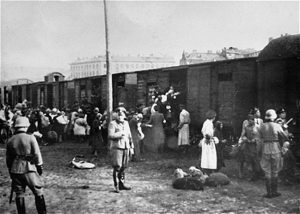
 could not even fall. Those who survived were to face an worse fate than dying on the train. They faced slavery, forced experimentation, and finally the gas chambers. Children were separated from parents, men from women, and the elderly simply sent straight to the gas chambers. People were mutilated, poisoned, beaten, forced to stand outside naked in the bitter cold of winter or in the heat of summer, crammed into quarters with no heat or blankets, and starved to death on a mere 700 calories or less a day. Death was the best option.
could not even fall. Those who survived were to face an worse fate than dying on the train. They faced slavery, forced experimentation, and finally the gas chambers. Children were separated from parents, men from women, and the elderly simply sent straight to the gas chambers. People were mutilated, poisoned, beaten, forced to stand outside naked in the bitter cold of winter or in the heat of summer, crammed into quarters with no heat or blankets, and starved to death on a mere 700 calories or less a day. Death was the best option.
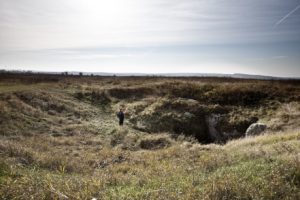 During World War II, and Jews who didn’t want to entrust their survival to the Nazis, had to make a way of escape or find a place to hide. For those who hoped against hope that the Nazis didn’t really hate them, or that the war would end very soon, the chance to escape came and went before they had really given the situation much thought. This was especially true for the Jewish people who had been born in the countries they now found themselves outcasts of.
During World War II, and Jews who didn’t want to entrust their survival to the Nazis, had to make a way of escape or find a place to hide. For those who hoped against hope that the Nazis didn’t really hate them, or that the war would end very soon, the chance to escape came and went before they had really given the situation much thought. This was especially true for the Jewish people who had been born in the countries they now found themselves outcasts of.
Zaida Stermer, his wife Esther, and their six children, of Korolowka, Ukraine, dug up the last of their possessions from behind their house, loaded their wagons with food and fuel, and drove away into the darkness. It was October 12, 1942. The Stermers weren’t alone. Traveling with them were about two dozen friends and family members, all Jews…and all in a lot of trouble. They had almost waited too long, and now the Nazis were out to kill all the Jews in the village. Ukraine had been under German occupation for about a year by then, and they had hoped that the war would end, and they could get back to their lives, but instead, the situation was exploding, and they had to get out while they still could.
The group made their way quietly about 5 miles to the north of town. With the Nazi “roundups and mass executions” of Ukrainian Jews in full swing, they were headed to a dirt road that ended at a sinkhole. There they made their way into a summertime tourist attraction known as the Verteba cave. They knew this was only  going to be a temporary solution, because in the summer, the tourists would be back, and they would be discovered. They hoped they had until summer.
going to be a temporary solution, because in the summer, the tourists would be back, and they would be discovered. They hoped they had until summer.
Modern cave explorers would not consider going underground without reliable light sources, technical and safety gear, navigation experience, clothing to stave off hypothermia, and of course an adequate supply of food and fresh water. The Stermers and their little band of survivors had none of these things. They went in in the dark, and had no light in the morning either. They fumbled their way further and further into the cave, hoping they could find there way back out. The cave had little ventilation and no real water supply, except what seeped through the rocks. Cooking was dangerous, and they almost lost a child to smoke inhalation. They moved the cooking further into the cave where they found better ventilation. Then came the worst night of all…
They had been in Verteba about four weeks, and thinking they might make it when their optimism was shattered. Suddenly in the dark they heard the sound of boots, and the rattling of guns. Someone yelled in Yiddish, “The Germans are here!! They’ve discovered us!!” Just as suddenly, and before anyone could think twice, Ester spoke up, “Very well, so you have found us. What do you think? Do you think that unless you kill us the Fuhrer will lose the war? Look at how we live her, like rats. All we want is to live, to survive the war years. Leave us here.” She was stalling!! She was allowing the others time to escape. As the stunned Germans listened to this little lady, the others hurried to the escape route they had found earlier. In the end, the  Germans only got eight of the cave dwelling Jews. Miraculously, Esther escaped. They hid out with friends throughout April 1943, but things were heating up again, and Esther told her family, “We are not going to the slaughterhouse.” She said to her son, Nissel, “Go to the forest, find a hole, anything.” It was thanks to Nissel that the family survived. Nissel located the cave known as the Priest’s Grotto. It was thought that the world record for living underground was 205 days, but the true record was set by the women and children who survived the Priest’s Grotto, by living completely underground for 344 days without seeing the outside world. It was a tough way to live, but they did survive, and that is a miracle.
Germans only got eight of the cave dwelling Jews. Miraculously, Esther escaped. They hid out with friends throughout April 1943, but things were heating up again, and Esther told her family, “We are not going to the slaughterhouse.” She said to her son, Nissel, “Go to the forest, find a hole, anything.” It was thanks to Nissel that the family survived. Nissel located the cave known as the Priest’s Grotto. It was thought that the world record for living underground was 205 days, but the true record was set by the women and children who survived the Priest’s Grotto, by living completely underground for 344 days without seeing the outside world. It was a tough way to live, but they did survive, and that is a miracle.
 When Hitler began his “Final Solution,” the Jewish people and several other groups of people had no idea what was coming their way. As people began to disappear and their families began to realize that Hitler was going to kill all of them, they began, in a panic, to try to figure out a way out of the German occupied areas of Europe. By the time people realized that they were in deep trouble, it was often too late, or nearly too late. Walls and fences surrounded them, with armed guards set up at all entrances to keep the people inside their prison walls. There seemed to be no way out.
When Hitler began his “Final Solution,” the Jewish people and several other groups of people had no idea what was coming their way. As people began to disappear and their families began to realize that Hitler was going to kill all of them, they began, in a panic, to try to figure out a way out of the German occupied areas of Europe. By the time people realized that they were in deep trouble, it was often too late, or nearly too late. Walls and fences surrounded them, with armed guards set up at all entrances to keep the people inside their prison walls. There seemed to be no way out.
This was where the resistance really came in. Some of the resistance personnel were Jewish people in the camps or towns, but some were the Christian citizens of the towns. They were not Jewish, and were not in trouble, but the felt a deep love for humanity and a deep sense of wrong and right. They could not stand by and do nothing, while people were killed. They took people into their homes, and built hiding places for them. Extra walls were built into rooms, making them slightly smaller, but providing a tiny space where the Jewish people they were helping could take refuge. It was a huge risk,  because if they were caught helping the Jewish people, they would be killed or sent to the work camps.
because if they were caught helping the Jewish people, they would be killed or sent to the work camps.
The Jewish people who were being hidden no longer had access to ration cards, so they could not buy food. The people who were hiding them had to share their food, meaning their own meager rations had to feed more people that before. Everyone lost weight. Everyone became weaker. People learned to find roots, mushrooms, berries and anything else they could forage in the forests…when they could get to the forest. Everyone was thinner in those days…dangerously thin, especially the Jewish people.
People, like Corrie ten Boom, who helped the Jewish people, gypsies, and Jehovah’s Witnesses, took great risks. Sometimes, they were turned in by their neighbors…for the reward money the Nazis offered. Other people hated the Jewish people as much as Hitler, and they turned them in out of hate. They didn’t care if there 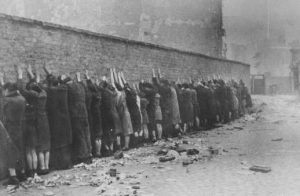 was a reward or not. Some people were as full of hate as the Nazis. Nevertheless, While the Nazis and the Nazi sympathizers were filled with hate, many people of that era were filled with love for their fellowman, and did not see the race, religious, or cultural differences. They just saw people, and knew they could not stand by, witnesses to the slaughter, and do nothing. The integrity of these people makes me wonder why things can’t be that way in our times. The best way bring change in any society is through love for one another…not hate. The people who fought against the Nazis and showed compassion for the Jewish people, gypsies, and Jehovah’s Witnesses, were willing to die to save people…not to destroy them.
was a reward or not. Some people were as full of hate as the Nazis. Nevertheless, While the Nazis and the Nazi sympathizers were filled with hate, many people of that era were filled with love for their fellowman, and did not see the race, religious, or cultural differences. They just saw people, and knew they could not stand by, witnesses to the slaughter, and do nothing. The integrity of these people makes me wonder why things can’t be that way in our times. The best way bring change in any society is through love for one another…not hate. The people who fought against the Nazis and showed compassion for the Jewish people, gypsies, and Jehovah’s Witnesses, were willing to die to save people…not to destroy them.
 During the Holocaust, the majority of known Jews in any given country, had a very slim chance of surviving the war, but the Denmark Jews somehow managed to hold an impressive 95% survival rate record. Much of that was due to one man, Georg Ferdinand Duckwitz, who became an unlikely hero of the Jewish people…mainly because he was a German diplomat serving as an attaché for Nazi Germany in occupied Denmark at the time. In fact, that is what makes what he did so strange.
During the Holocaust, the majority of known Jews in any given country, had a very slim chance of surviving the war, but the Denmark Jews somehow managed to hold an impressive 95% survival rate record. Much of that was due to one man, Georg Ferdinand Duckwitz, who became an unlikely hero of the Jewish people…mainly because he was a German diplomat serving as an attaché for Nazi Germany in occupied Denmark at the time. In fact, that is what makes what he did so strange.
Duckwitz was born on September 29, 1904, in Bremen, Germany. He was part of an old patrician family in the Hanseatic City. After college, he began a career in the international coffee trade. From 1928 until 1932 Duckwitz lived in Copenhagen, Denmark. Upon moving back to Bremen, November 1932 he met Gregor Strasser, who was the leader of the leftist branch of the German nationalistic Nazi Party. While talking to Strasser, Duckwitz found that “elements of Scandinavian socialism [were] connected with nationalistic feelings” and this led to his decision to join the Nazi Party, and subsequently on July 1, 1933, to join the Nazi Party’s Office of Foreign Affairs in Berlin.
What had at first seemed to him to be a party who’s values agreed with his, he soon became increasingly disillusioned by Nazi politics. In a letter written June 4, 1935 to Alfred Rosenberg, the head of the office, he wrote, “My two-year employment in the Reichsleitung [i.e. executive branch] of the [Nazi Party] has made me realize that I am so fundamentally deceived in the nature and purpose of the National Socialist movement that I am no longer able to work within this movement as an honest person.” That move in itself strikes me now, as scary, considering how the known Nazi party functioned. He may not have realized hoe dangerous his words were, but I think they could have gotten him killed. Around the same time the Gestapo (secret police) made its first notes on Duckwitz after he sheltered three Jewish women in his Kurfürstendamm apartment during a local anti-Semitic Sturmabteilung event. He later wrote that during this time period he became “a fierce opponent of this [Nazi] system”.
After 1942, Duckwitz worked with the Nazi Reich representative Werner Best, who organized the Gestapo. On September 11, 1943 Best told Duckwitz about the intended round-up of all Danish Jews on October 1, 1943. A horrified Duckwitz travelled to Berlin in an attempt to stop the deportation through official channels. When that failed, he flew to Stockholm two weeks later, saying he was going to discuss the passage of German merchant ships. While there, he contacted Prime Minister Per Albin Hansson and asked whether Sweden would be willing to receive Danish Jewish refugees. A couple of days later, Hansson came back with the promise of a favorable reception. On September, 29, 1943, Duckwitz contacted Danish social democrat Hans Hedtoft and notified him of the intended deportation. Hedtoft warned the head of the Jewish community CB Henriques and the acting chief rabbi Marcus Melchior, who spread the warning. Sympathetic Danes in all walks of life organized an immediate mass escape of over 7,200 Jews and 700 of their non-Jewish relatives by sea to Sweden. Duckwitz’ immediate action and the willingness of the Danish and Swedish citizens saved the lives of 95% of Denmark’s Jewish population. They were the only European nation to save almost all their Jewish population from certain death at the hand’s of Hitler’s evil regime.
Somehow, Duckwitz was never caught committing his act of “treason” against the Third Reich, and he stayed in good standing with the Nazi regime. After the war, Duckwitz remained in the German foreign service. From 1955–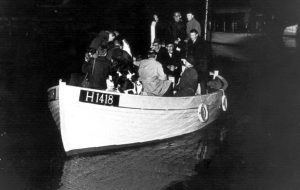 1958 Duckwitz served as West German ambassador to Denmark and later as the ambassador to India. When Willy Brandt became Foreign Minister in 1966, he made Duckwitz Secretary of State in West Germany´s Foreign Office. After Brandt became Chancellor, he asked Duckwitz to negotiate an agreement with the Polish government. Brandt’s work culminated in the 1970 Treaty of Warsaw. Duckwitz worked as Secretary of State until his final retirement in 1970. On March 21, 1971 the Israeli government named him Righteous Among the Nations and included him in the Yad Vashem memorial. He died two years later, on February 16, 1973 at the age of 68.
1958 Duckwitz served as West German ambassador to Denmark and later as the ambassador to India. When Willy Brandt became Foreign Minister in 1966, he made Duckwitz Secretary of State in West Germany´s Foreign Office. After Brandt became Chancellor, he asked Duckwitz to negotiate an agreement with the Polish government. Brandt’s work culminated in the 1970 Treaty of Warsaw. Duckwitz worked as Secretary of State until his final retirement in 1970. On March 21, 1971 the Israeli government named him Righteous Among the Nations and included him in the Yad Vashem memorial. He died two years later, on February 16, 1973 at the age of 68.
 People aren’t usually evil. Nor are the easily accepting of evil. Usually, in order to get people to accept evil, it has to be hidden in a way. It has to be slipped in when they aren’t looking…slowly, so that it is accepted as normal…or a new normal. When Hitler ordered the systematic murder of the mentally ill and handicapped people in 1939, the people of Germany were outraged. Never before had any leader made such a boldly, callous move. Like throwing a frog in a pot of boiling water, they jumped…fought back.
People aren’t usually evil. Nor are the easily accepting of evil. Usually, in order to get people to accept evil, it has to be hidden in a way. It has to be slipped in when they aren’t looking…slowly, so that it is accepted as normal…or a new normal. When Hitler ordered the systematic murder of the mentally ill and handicapped people in 1939, the people of Germany were outraged. Never before had any leader made such a boldly, callous move. Like throwing a frog in a pot of boiling water, they jumped…fought back.
Hitler moved too fast, and the people rebelled. The program, known as Hitler’s Euthanasia Department that began in 1939, came under the heading of unhidden evil. Hitler misjudged his people. He thought they would follow blindly along. When they began complaining about the T.4 program, which began as the systematic killing of children deemed “mentally defective,” Hitler had to act. He had been transporting children from all over Germany to a Special Psychiatric Youth Department and killing them. Later, certain criteria were established for non-Jewish children. They had to be “certified” mentally ill, schizophrenic, or incapable of working for one reason or another. Jewish children already in mental hospitals, whatever the reason or whatever the prognosis, were automatically to be subject to the program. The victims were either injected with lethal substances or were led to “showers” where the children sat as gas flooded the room through water pipes. The program was then expanded to adults. The program was heinous in every way.
Before long the outraged protests began mounting within Germany, especially by doctors and clergy. Some of them even dared to write to Hitler directly and describe the T.4 program as “barbaric.” Others circulated their opinions more discreetly. Heinrich Himmler, was the head of the SS then, and the man who would direct the systematic extermination of European Jewry. Himmler had only one regret…that the SS had not been put in charge of the T.4 program. He says of the protesting, “We know how to deal with it correctly, without causing useless uproar among the people.” Finally, in 1941, Bishop Count Clemens von Galen denounced the euthanasia 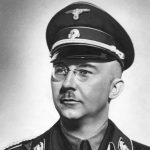 program from his pulpit. Hitler was concerned that other nations would get involved with such publicity about his program. He ordered the program suspended on August 18, 1941…at least in Germany. But 50,000 people had already fallen victim to it.
program from his pulpit. Hitler was concerned that other nations would get involved with such publicity about his program. He ordered the program suspended on August 18, 1941…at least in Germany. But 50,000 people had already fallen victim to it.
Hitler was not to be deterred. He now knew that he had to keep his programs hidden, if he was going to be able to carry out his plans. So, he revived the program in occupied Poland. The people there already had no say in the matter, and he hoped that it would be far enough from Germany so that the German people would not know what was going on. It worked for a time, but in the end, the world would know about the evil he tried so hard to keep hidden, and in the end the number of murder victims was far more than a mere 50,000…it was more like 11 million people.
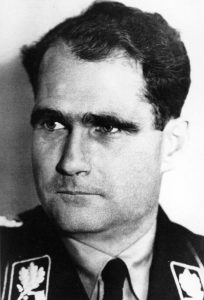 Spandau Prison was located on Wilhelmstraße in the borough of Spandau in western Berlin. It was constructed in 1876. It initially served as a military detention center. From 1919 it was also used for civilian inmates. It held up to 600 inmates at that time.
Spandau Prison was located on Wilhelmstraße in the borough of Spandau in western Berlin. It was constructed in 1876. It initially served as a military detention center. From 1919 it was also used for civilian inmates. It held up to 600 inmates at that time.
Rudolf Walter Richard Heß was born on April 26, 1894 in Ibrahimieh, a suburb of Alexandria, Egypt, which was at that time under British occupation, even though it was a part of the Ottoman Empire. Heß was born into a wealthy German family. His parents were Johann Fritz Heß and Klara Munch Heß. He was a German politician and a leading member of the Nazi Party in Nazi Germany. Heß was appointed Deputy Führer to Adolf Hitler in 1933, and served in that position until 1941, when he flew solo to Scotland in an attempt to negotiate peace with the United Kingdom during World War II. He was taken prisoner and eventually convicted of crimes against peace, serving a life sentence. I’m not sure what he thought he was going to accomplish, going in there by himself, or if he later thought he could get back in Hitler’s “good graces,” but the attempt ended his freedom for the rest of his life.
Heß joined the Nazi Party on July 1, 1920 and was at Hitler’s side on November 8, 1923 for the Beer Hall Putsch, a failed Nazi attempt to seize control of the government of Bavaria. While serving time in jail for this attempted coup, he assisted Hitler with his book, “Mein Kampf,” which became a foundation of the political platform of the Nazi Party. Hitler decreed on the outbreak of war on September 1, 1939 that Hermann Göring was his official successor, and named Heß as next in line. In addition to appearing on Hitler’s behalf at speaking engagements and rallies, Heß signed into law much of the government’s legislation, including the Nuremberg Laws of 1935, which stripped the Jews of Germany of their rights in the lead-up to the Holocaust.
When Heß made his solo flight to Scotland on May 10, 1941, it would appear he was willingly committing treason against his government, but that did not impress the British government, who probably thought it was all a ploy…and maybe it was. Most of us will never know. Heß was arrested and finished out the war in a British prison camp. When the war ended, he was returned to Germany to stand trial in the Nuremberg Trials of major war-criminals in 1946. During much of the trial, he claimed to be suffering from amnesia, but he later admitted this was a ruse. The Court convicted him of crimes against peace and of conspiracy with other German leaders to commit crimes. He was to served a life sentence in Spandau Prison…the Soviet Union blocked repeated attempts by family members and prominent politicians to win his early release.
During the time Heß was at Spandau Prison, there were only seven prisoners there. Konstantin von Neurath, Erich Raeder, Karl Dönitz, Walther Funk, Albert Speer, Baldur von Schirach, and Heß. The men all arrived at Spandau from Nuremberg on July 18, 1947. Of the seven, three were released after serving their full sentences, while three others, including Raeder and Funk, who were given life sentences, were released earlier due to ill health. Between 1966 and 1987, Rudolf Hess was the only inmate in the prison and his only companion was the warden, Eugene K Bird, who became a close friend. Bird wrote a book about Hess’s imprisonment titled The Loneliest Man in the World. In his book he claims to have been told what Heß’s intentions were during his ill-fated attempt at peace talks in 1941.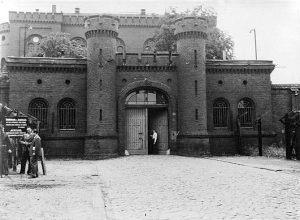
I can’t imagine what it must have been like to be the only prisoner in a prison that once held 600 men. My guess is that it was lonely for the warden too, although he could leave when he wanted to, and Heß could not. The men did develop a friendship, but that cannon really change the feel of emptiness that persisted over the prison for 21 long years of virtual emptiness. While Heß lived a long life, the isolation finally got the better of him, and he hanged himself on August 17, 1987. He was 93 years old. Following his death, the prison was demolished, because the authorities did not want it to become a neo-Nazi shrine. The site was later rebuilt as a shopping center for the British forces stationed in Germany.
 When the Nazis began their annihilation of of the Jewish people, many were caught completely unaware. I think it’s impossible to think that anyone could do such horrible things to other human beings. Many of the Jews actually went along with how things were going…at first. By the time they realized the predicament they were in, it was too late. Other Jews, somehow knew that moving into the “ghetto” was the beginning of their end. Some thought they would never leave their homeland, but would rather wait out the war, which would “be over before they knew it,” but it wasn’t over…not for a long time, and for some ended only in death. Many Jewish families wouldn’t survive the war, at least not intact. Over the years of the war, no Jews could say they didn’t know anyone who had died, because they all knew some who had died, and often it was their own family members.
When the Nazis began their annihilation of of the Jewish people, many were caught completely unaware. I think it’s impossible to think that anyone could do such horrible things to other human beings. Many of the Jews actually went along with how things were going…at first. By the time they realized the predicament they were in, it was too late. Other Jews, somehow knew that moving into the “ghetto” was the beginning of their end. Some thought they would never leave their homeland, but would rather wait out the war, which would “be over before they knew it,” but it wasn’t over…not for a long time, and for some ended only in death. Many Jewish families wouldn’t survive the war, at least not intact. Over the years of the war, no Jews could say they didn’t know anyone who had died, because they all knew some who had died, and often it was their own family members.
One such family, the Shwartz family managed over the years of the war to escape time after time to emerge intact…against all odds. The family had been hit by loss, of course, but not at the hands of the Nazis. At first their lives weren’t affected. They lived in the country, and the “ghettos” seemed so far away. Then it started. It began with the Russians, yes Russians…they had been there at first in an effort to hold back the Germans, but in this case, they weren’t much better than the Germans. At first they took the vegetables and livestock to feed the soldiers, then they took the home. So the family moved.
When the Germans invaded, the family moved to a different town, but before long they were expected to go to the “ghettos.” Instead, they made their escape from Poland to Romania. Before long the family had to be split up to protect themselves. They lived in barns and small sheds, but still they weren’t really safe. They finally had to put their children up for adoption to Christian families, but even that wasn’t safe later on, and the children ended up back with their own parents. Eventually, one of the children at all of ten years old, decided that he was going to Palestine. He went, but they thought he had died when the ship sank. In reality, he was on a different ship, because his ship had been overbooked.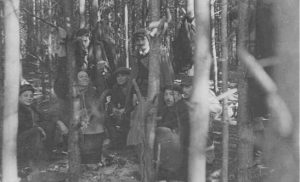
His aunt had also been with the family, and she had been able to move around under the radar, because of her blonde hair and blue eyes. She didn’t look Jewish. During one border crossing, the family was caught by German Gestapo, but the men were young and they were able to fool them into thinking they belonged. Of course, I am oversimplifying their entire ordeal, but miraculously, they entire family live through the Holocaust, without ending up in the camps, and in the end, they moved to Palestine, where they still live today.
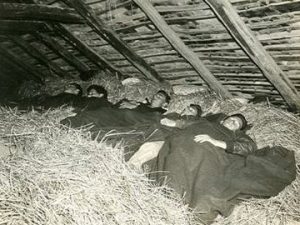 On January 24, 1944, the first of over 500 American airmen bailed out of their disabled planes over the German-occupied zone of Serbia. That first day, the Germans shot down two Liberators…one over Zlatibor and the other over Toplica. One bomber made an emergency landing between Plocnik and Beloljin. That crew of nine men were rescued by the Chetnik Toplica Corps under the command of Major Milan Stojanovic. The crew were placed in the home of local Chetnik leaders in the village of Velika Dragusa. The other bomber crew bailed out over Mount Zlatibor. They were found by members of the Zlatibor Corps. A radiogram message on the rescue of one of the crews was sent by Stojanovic to Mihailovic on January 25th. Major Stojanovic wrote that the previous day about 100 bombers flew from the direction of Nis towards Kosovska Mitrovica, and that they were followed by nine German fighter aircraft. After a half-hour battle, one plane caught fire and was forced to land between the villages of Plocnik and Beloljin, in the Toplica River valley.
On January 24, 1944, the first of over 500 American airmen bailed out of their disabled planes over the German-occupied zone of Serbia. That first day, the Germans shot down two Liberators…one over Zlatibor and the other over Toplica. One bomber made an emergency landing between Plocnik and Beloljin. That crew of nine men were rescued by the Chetnik Toplica Corps under the command of Major Milan Stojanovic. The crew were placed in the home of local Chetnik leaders in the village of Velika Dragusa. The other bomber crew bailed out over Mount Zlatibor. They were found by members of the Zlatibor Corps. A radiogram message on the rescue of one of the crews was sent by Stojanovic to Mihailovic on January 25th. Major Stojanovic wrote that the previous day about 100 bombers flew from the direction of Nis towards Kosovska Mitrovica, and that they were followed by nine German fighter aircraft. After a half-hour battle, one plane caught fire and was forced to land between the villages of Plocnik and Beloljin, in the Toplica River valley.
Over the next few months, more planes were shot down, and more crews were rescued by the Serbian resistance. In all it was thought that 432 men had been hidden, effectively saving them from the German prison camps. In the end, it was determined that the actual number of men in need of rescue was 512. The men had no way of knowing that they would be “guests” of the Serbian resistance for 7 long months, and in some cases longer.
The two resistance groups, Marshal Tito’s Partisans and Draza Mihailovic’s Chetniks, both hated the Nazis vehemently, and they also hated each other. It made working together difficult at best. Still, they shared a common goal…to defeat the Nazis, and they were willing to do what was necessary to achieve that goal. While it was sometimes possible to smuggle the airmen out and reunite them with their units, it was not always possible. When they could not get the men out, they kept them in their homes, and shared what little food they had with them.
In July 1944, these men again came to the attention of the Office of Strategic Services (OSS), and they began to draw up plans to bring the men home. I’m sure by then, the men thought they really had been forgotten, or maybe that no one knew about them at all, but now they were going to be going home. Operation Halyard, the operation to bring home these men, commenced on August 9, 1944 and continued until December 28, 1944. The men would be airlifted out of Serbia 12 men at a time, but before any airlift could take place, they had to build an airstrip. The C-47 cargo plane required 700 feet of runway for takeoffs and landings. The men and the 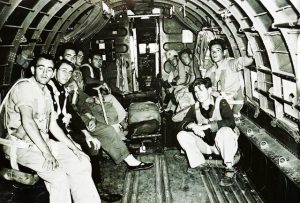 people of Serbia built an airstrip that was exactly 700 feet long. It was bordered by forest and mountains, so the takeoffs and landings would have to be precise. According to historian Professor Jozo Tomasevich, a report submitted to the OSS showed that 417 Allied airmen who had been downed over occupied Yugoslavia were rescued by Mihailovic’s Chetniks, and airlifted out by the Fifteenth Air Force. According to Lieutenant Commander Richard M Kelly (OSS), a grand total of 432 United States and 80 Allied personnel were airlifted during the Halyard Mission. In the end, at least in this mission, the military lived up to its motto, “Never leave a man behind.”
people of Serbia built an airstrip that was exactly 700 feet long. It was bordered by forest and mountains, so the takeoffs and landings would have to be precise. According to historian Professor Jozo Tomasevich, a report submitted to the OSS showed that 417 Allied airmen who had been downed over occupied Yugoslavia were rescued by Mihailovic’s Chetniks, and airlifted out by the Fifteenth Air Force. According to Lieutenant Commander Richard M Kelly (OSS), a grand total of 432 United States and 80 Allied personnel were airlifted during the Halyard Mission. In the end, at least in this mission, the military lived up to its motto, “Never leave a man behind.”

